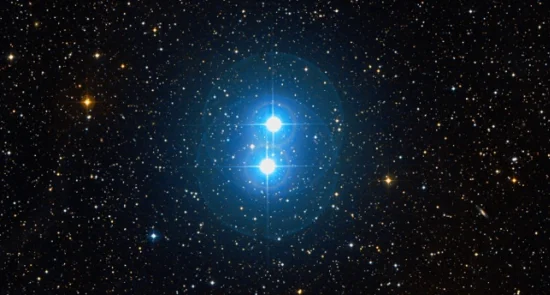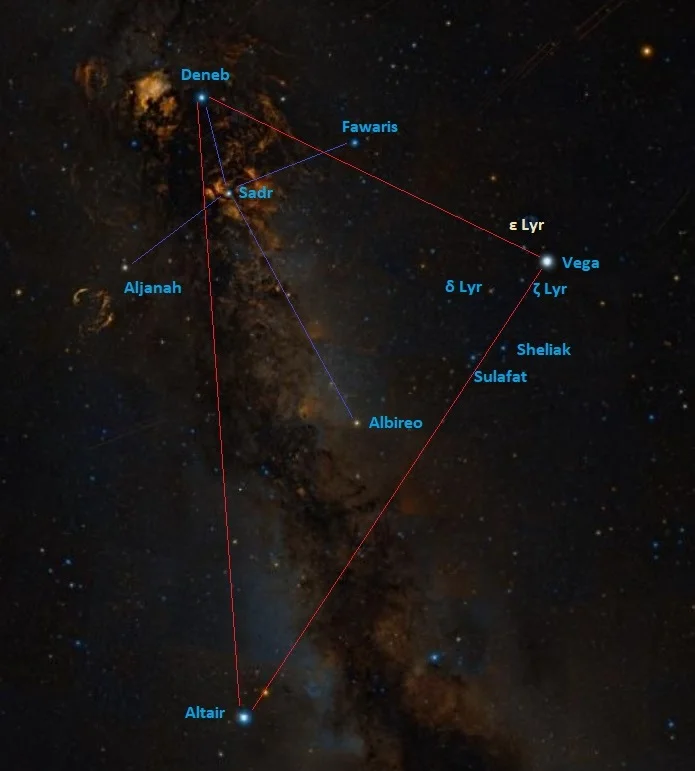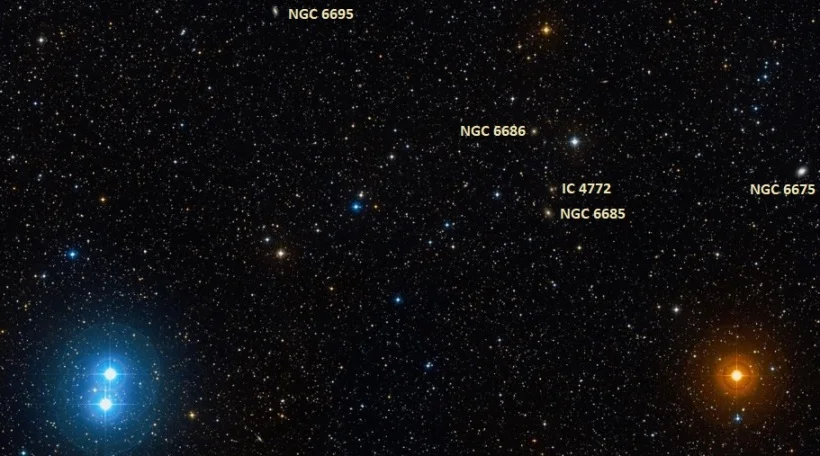Epsilon Lyrae, popularly known as the Double Double, is a multiple star system located in the constellation Lyra. Composed of at least five stars, the system lies at an approximate distance of 160 light years from Earth. The two brightest components, Epsilon1 Lyrae and Epsilon2 Lyrae, have apparent magnitudes of 4.66 and 4.59 and are visible without binoculars from areas without light-pollution. Telescopes resolve each component into a pair of white stars, making the Double Double a popular target among both stargazers and astronomers.
Star system
Epsilon Lyrae is a star system consisting of five or more stars. In good conditions, two components are visible to the unaided eye. They are designated Epsilon1 Lyrae and Epsilon2 Lyrae. Epsilon1 appears 208 arcseconds north of the slightly brighter Epsilon2. The two components are over 0.16 light years (10,500 astronomical units) apart and orbit each other with a period of over 400,000 years.
In telescopes, each of the components is resolved into a pair of stars in close orbit, earning the system the nickname Double Double. The components of Epsilon1 Lyrae – Epsilon1 Lyrae A and Epsilon1 Lyrae B – are separated by about 2.6 arcseconds. They have apparent magnitudes of 4.7 and 6.2 and shine at a combined magnitude of 4.66 from a distance of 162 light years. The two stars complete an orbit every 1,804.41 years. The physical distance between them is about 140 astronomical units. The stars have a highly eccentric orbit that brings them as close together as 73 astronomical units and takes them as far apart as 400 astronomical units.

Epsilon Lyrae, image: Wikisky
The components of Epsilon2 Lyrae – Epsilon2 Lyrae A and Epsilon2 Lyrae B – are a bit closer to us, at a distance of 156 light years. They appear 2.3 arcseconds apart and have apparent magnitudes of 5.1 and 5.5. Together, they shine at magnitude 4.59. Their orbital period is 724.307 years, less than half that of Epsilon1. The physical distance between the stars is 145 astronomical units. As they orbit, the two components come within 95 astronomical units of each other and drift as far apart as 195 astronomical units.
Epsilon2 Lyrae A was discovered to be a binary system using speckle interferometry in 1985. The two components are believed to have an orbital period of only a few tens of years. They are separated by 0.2 arcseconds or less (5 astronomical units) and the companion has not been observed directly.
The four visible components of the Epsilon Lyrae system appear quite similar. Epsilon1 Lyrae A is a white main sequence star of the spectral type A3V. It has a mass of 2.03 solar masses and shines with 24 solar luminosities with a surface temperature of 7,943 K. The star is a fast spinner, with a projected rotational velocity of 165 km/s.
Epsilon1 Lyrae B has the stellar classification F0V, indicating another white hydrogen-fusing dwarf. The star has a mass 1.61 times that of the Sun and a radius double that of our star. With an effective temperature of 7,047 K, it is 6.874 times more luminous than the Sun. Like its binary companion, it is a fast rotator, with a projected rotational velocity of 159 km/s.
The two main components in the Epsilon2 Lyrae system are both white, class A main sequence stars. Epsilon2 Lyrae A has the stellar classification A6Vn, while Epsilon2 Lyrae B is of the spectral type A7Vn.
Epsilon2 Lyrae A has a mass of 2.11 solar masses and is 29 times more luminous than the Sun. It has a surface temperature of 7,816 K and spins at 212 km/s.
Epsilon2 Lyrae B has a mass 2.15 times that of the Sun and shines with 32 solar luminosities with an effective temperature of 7,852 K. Like other components in the Epsilon Lyrae system, the star is a very fast spinner, with a projected rotational velocity of 233 km/s.
The estimated age of the system is about 800 million years.
Facts
In Chinese astronomy, Epsilon Lyrae is part of an asterism known as Weaving Girl (織女, Zhī Nǚ). The asterism is formed by Vega, Epsilon1 Lyrae and Zeta1 Lyrae. It is part of the Ox mansion, one of the northern mansions of the Black Tortoise. The asterism is associated with the Chinese folk tale of the Cowherd and the Weaver Girl, two lovers represented by the stars Altair and Vega. In the tale, their love is not allowed, and they are banished to opposite sides of a large river, represented by the Milky Way. They can only meet once a year when magpies create a bridge across the river. Their annual meeting is celebrated with a festival traditionally held on the seventh day of the seventh month of the Chinese lunar calendar.
Location
The Double Double is quite easy to find because it lies next to Vega, the fifth brightest star in the sky and second brightest in the northern celestial hemisphere, after Arcturus. Vega is one of the three first-magnitude stars that form the Summer Triangle, a prominent asterism that dominates the northern summer sky. Deneb in the constellation Cygnus and Altair in Aquila mark the other two vertices. Deneb is recognizable because it sits at the top of the Northern Cross, another familiar summer asterism, and Altair is identified by the two relatively bright stars flanking it, Alshain and Tarazed.

Epsilon Lyrae location, image: Wikisky
Meanwhile, Vega is recognized as the brightest star next to the distinctly lyre-shaped pattern that dominates the constellation Lyra. Epsilon Lyrae appears just northeast of Vega, in the same binocular field of view.

Lyra stars, image: Wikisky
Epsilon Lyrae can be used to find several relatively bright galaxies that appear in the vicinity of the star and north of the brighter Vega. These are NGC 6675, NGC 6685, NGC 6695, NGC 6686, and IC 4772.

Epsilon Lyrae, NGC 6675, NGC 6685, IC 4772, NGC 6686 and NGC 6695, image: Wikisky
Constellation
Epsilon Lyrae is located in the constellation Lyra. Associated with the lyre of Orpheus in Greek mythology, Lyra is one of the 48 Greek constellations, first catalogued by Claudius Ptolemy of Alexandria in his Almagest in the 2nd century CE.
Lyra is one of the smaller constellations, 52nd in size, occupying an area of 286 square degrees of the northern sky between the larger Cygnus and Hercules. However, it is one of the most distinctive northern constellations, with a prominent diamond-shaped asterism just below its luminary Vega.

Lyra constellation map by IAU and Sky&Telescope magazine
Lyra is home to many notable stars. Other than Vega and Epsilon Lyrae, these include the blue giant Sulafat (Gamma Lyrae), the star system Beta Lyrae (Sheliak), a prototype for its own class of variable stars, the red bright giant Delta2 Lyrae, the orange giant Kappa Lyrae, the semiregular variable red giant R Lyrae, and the pulsating variable RR Lyrae, another class prototype.
Lyra also contains the Ring Nebula (Messier 57), one of the brightest planetary nebulae in the sky, and the bright globular cluster Messier 56. Other interesting deep sky objects in the constellation include the open cluster NGC 6791, the irregular galaxy NGC 6745, and the barred spiral galaxy IC 1296.
The best time of year to see the stars and deep sky objects in Lyra is during the month of August, when the constellation rises high overhead in the evening sky. The entire constellation is visible from locations between the latitudes 90° N and 40° S.
The 10 brightest stars in Lyra are Vega (Alpha Lyrae, mag. 0.026), Sulafat (Gamma Lyrae, mag. 3.261), Sheliak (Beta Lyrae A, mag. 3.52), R Lyrae (mag. 4.00), Delta2 Lyrae (mag. 4.22), Kappa Lyrae (mag. 4.35), Zeta1 Lyrae (mag. 4.34), Theta Lyrae (mag. 4.347), Aladfar (Eta Lyrae, mag. 4.40), and Epsilon2 Lyrae A (mag. 4.59).
Epsilon Lyrae
| Spectral class | A3V + F0V, A6Vn + A7Vn |
| Constellation | Lyra |
| Names and designations | Epsilon Lyrae, ε Lyrae, ε Lyr, ADS 11635, WDS 18443+3940 |
Epsilon1 Lyrae
| Spectral class | A3V + F0V |
| U-B colour index | +0.065 |
| B-V colour index | +0.16 |
| Apparent magnitude | 4.66 |
| Distance | 162 ± 6 light years (50 ± 2 parsecs) |
| Parallax | 20.10 ± 0.78 mas |
| Radial velocity | −31.20 ± 1.7 km/s |
| Proper motion | RA: 11.09 ± 0.70 mas/yr |
| Dec.: 61.39 ± 0.87 mas/yr | |
| Right ascension | 18h 44m 20.34589s |
| Declination | +39° 40′ 12.4533″ |
| Names and designations | ε1 Lyrae, ε1 Lyr, 4 Lyrae, HD 173582J, HIP 91919, BD+39 3509, AG+39 1834, PPM 81725, UBV 15949, IRAS 18426+3937, 2MASS J18442032+3940134, ADS 11635 AB, CCDM J18443+3938AB, IDS 18410+3934, WDS J18443+3940AB |
Epsilon1 Lyrae A
| Spectral class | A3V |
| Apparent magnitude | 4.7 |
| Parallax | 17.9665 ± 0.2274 mas |
| Radial velocity | −31 ± 2 km/s |
| Proper motion | RA: 9.297 ± 0.484 mas/yr |
| Dec.: 75.291 ± 0.477 mas/yr | |
| Mass | 2.03 M☉ |
| Luminosity | 24 L☉ |
| Temperature | 7,943 K |
| Rotational velocity | 165 km/s |
| Right ascension | 18h 44m 20.3500662690s |
| Declination | +39° 40′ 12.262845991″ |
| Names and designations | ε1 Lyrae A, ε1 Lyr A, 4 Lyrae A, HD 173582, HR 7051, SAO 67310, BD+39 3509A, GC 25667, GCRV 11194, PLX 4326, TYC 3122-3438-2, Gaia DR2 2098237660363229312, ADS 11635 A, CCDM J18443+3938A, WDS J18443+3940A |
Epsilon1 Lyrae B
| Spectral class | F0V |
| Apparent magnitude | 6.2 |
| Parallax | 20.4080 ± 0.0507 mas |
| Radial velocity | −33 ± 2 km/s |
| Proper motion | RA: 1.828 ± 0.105 mas/yr |
| Dec.: 49.549 ± 0.089 mas/yr | |
| Mass | 1.61 M☉ |
| Luminosity | 6.874 L☉ |
| Radius | 2 R☉ |
| Temperature | 7,047 K |
| Rotational velocity | 159 km/s |
| Right ascension | 18h 44m 20.3122868571s |
| Declination | +39° 40′ 14.885241841″ |
| Names and designations | ε1 Lyrae B, ε1 Lyr B, 4 Lyrae B, HD 173583, HR 7052, SAO 67309, BD+39 3509B, GC 25666, GCRV 11193, TYC 3122-3438-1, Gaia DR2 2098237656065233792, ADS 11635 B, CCDM J18443+3938B, WDS J18443+3940B |
Epsilon2 Lyrae
| Spectral class | A6Vn + A7Vn |
| U-B colour index | +0.075 |
| B-V colour index | +0.18 |
| Apparent magnitude | 4.59 |
| Distance | 156 ± 4 light years (48 ± 1 parsecs) |
| Parallax | 20.97 ± 0.50 mas |
| Radial velocity | −24.40 ± 1.7 km/s |
| Proper motion | RA: 6.18 ± 0.39 mas/yr |
| Dec.: 50.42 ± 0.73 mas/yr | |
| Right ascension | 18h 44m 22.78056s |
| Declination | +39° 36′ 45.7851″ |
| Names and designations | Epsilon2 Lyrae, ε2 Lyr, 5 Lyrae, HD 173607J, HIP 91926, BD+39 3510, AG+39 1835, PPM 81726, IRAS 18427+3933, 2MASS J18442286+3936459, UBV 15950, ADS 11635 CD, CCDM J18443+3938CD, IDS 18410+3934 CD, AAVSO 1841+39, WDS J18443+3940CD |
Epsilon2 Lyrae A
| Spectral class | A6Vn |
| Apparent magnitude | 5.1 |
| Parallax | 20.1945 ± 0.1275 mas |
| Radial velocity | −24.2 ± 2 km/s |
| Proper motion | RA: 6.967 ± 0.315 mas/yr |
| Dec.: 49.926 ± 0.257 mas/yr | |
| Mass | 2.11 M☉ |
| Luminosity | 29 L☉ |
| Temperature | 7,816 K |
| Rotational velocity | 212 km/s |
| Right ascension | 18h 44m 22.7793399199s |
| Declination | +39° 36′ 45.758096219″ |
| Names and designations | Epsilon2 Lyrae A, ε2 Lyr A, 5 Lyrae A, HD 173607, HR 7053, SAO 67315, GC 25668, GCRV 11195, TYC 3122-3439-1, Gaia DR2 2098202128093842432, ADS 11635 C, CCDM J18443+3938C, IDS 18410+3934 C, WDS J18443+3940C, WDS J18443+3940Ca,Cb |
Epsilon2 Lyrae B
| Spectral class | A7Vn |
| Apparent magnitude | 5.5 |
| Parallax | 20.0603 ± 0.1196 mas |
| Radial velocity | −28 ± 5 km/s |
| Proper motion | RA: 4.138 ± 0.227 mas/yr |
| Dec.: 66.448 ± 0.200 mas/yr | |
| Mass | 2.15 M☉ |
| Luminosity | 32 L☉ |
| Temperature | 7,852 K |
| Rotational velocity | 233 km/s |
| Right ascension | 18h 44m 22.9837964219s |
| Declination | +39° 36′ 46.051704135″ |
| Names and designations | Epsilon2 Lyrae B, ε2 Lyr B, 5 Lyrae B, HD 173608, HR 7054, GCRV 11196, TYC 3122-3439-2, Gaia DR2 2098202128100428288, ADS 11635 D, CCDM J18443+3938D, IDS 18410+3934 D, WDS J18443+3940D |